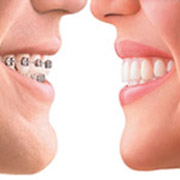Invisalign Compared to Braces
 The Invisalign system is a popular alternative to traditional braces for patients concerned about discretion in their treatment. However, appearance is just one of the advantages in which Invisalign differs from braces. Here is more about the differences between these two options.
The Invisalign system is a popular alternative to traditional braces for patients concerned about discretion in their treatment. However, appearance is just one of the advantages in which Invisalign differs from braces. Here is more about the differences between these two options.
Attachment to Teeth
Metal braces are structurally bonded to the teeth with brackets and wires, while Invisalign uses clear plastic aligners that fit over the teeth and can be removed. This enables easier cleaning for patient’s and facilitates good oral health overall.
Potential for Abrasion
The brackets of metal braces can abrade the cheeks, especially during action sports. The smooth plastic aligners used with Invisalign completely eliminate this issue. When prospective patients read Invisalign reviews, they will notice that the comfort of Invisalign garners consistent praise from recipients.
Treatment Time and Cost
Compared to metal braces, Invisalign is usually a faster treatment and can be cheaper, too. Invisalign is complete in an average of 15 months, whereas metal braces commonly require two years to straighten teeth.
Ability to Correct Bite Irregularities
Invisalign and metal braces are nearly equal in their ability to correct bite irregularities. Overbite, underbite, crossbite, improper rotation and bad spacing can all be resolved with either treatment. However, Invisalign has some limitations and cannot move teeth vertically. Some issues, such as narrow palate, cannot be corrected with either treatment and will require additional orthodontic appliances.
The advantages of Invisalign are especially prominent during treatment, but the positive changes it makes will last for a lifetime. Tooth decay, gum disease and tooth loss are less likely to occur with straight teeth, so seeking treatment can help save your oral health. At a consultation with our Beverly Hills Invisalign expert, patients can learn more about how these two orthodontic options compare with each other.
Back to Blog
